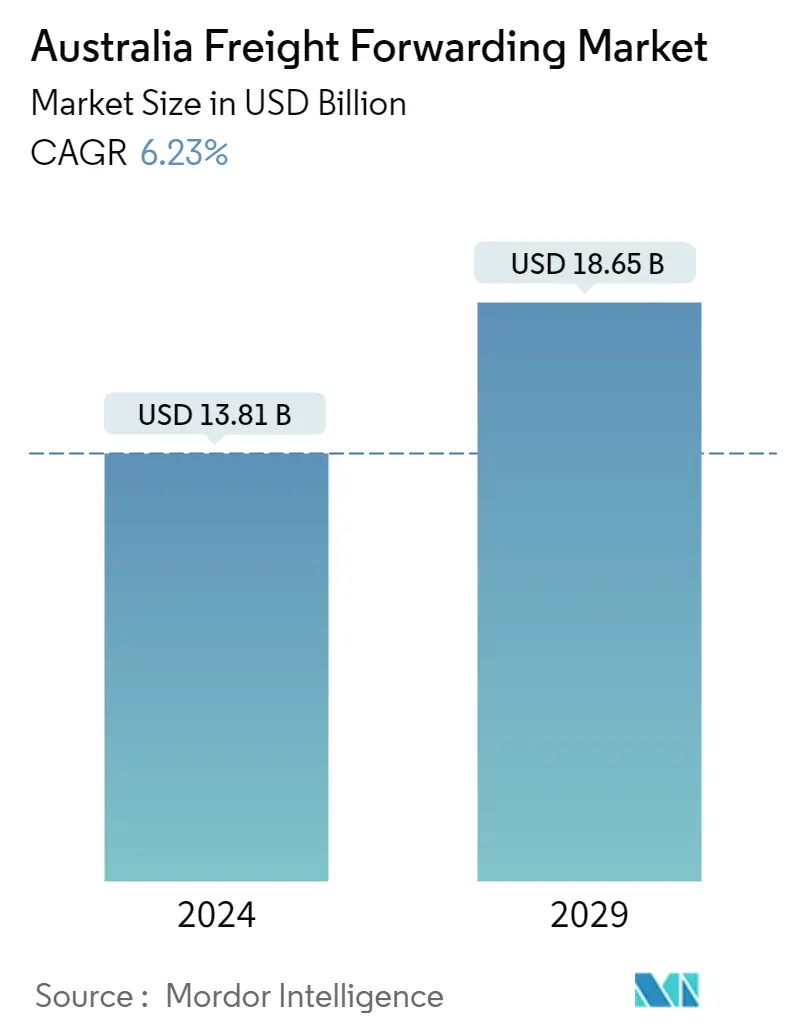Market Size of Australia Freight Forwarding Industry

| Study Period | 2019 - 2029 |
| Base Year For Estimation | 2023 |
| Market Size (2024) | USD 13.81 Billion |
| Market Size (2029) | USD 18.65 Billion |
| CAGR (2024 - 2029) | 6.23 % |
| Market Concentration | Low |
Major Players
*Disclaimer: Major Players sorted in no particular order |
Australia Freight Forwarding Market Analysis
The Australia Freight Forwarding Market size is estimated at USD 13.81 billion in 2024, and is expected to reach USD 18.65 billion by 2029, growing at a CAGR of 6.23% during the forecast period (2024-2029).
- Over the last four decades, Australia's domestic freight challenge continuously grew, with road and rail freight increasingly dominating domestic freight activity. Iron ore rail transport in the Pilbara area generated a massive surge in rail freight tasks. An efficient, sustainable, and cost-effective freight and logistics business supported by collaboration with all levels of government supports Australia's rising economy and ambitions for a high quality of life.
- The COVID-19 epidemic resulted in an exponential spike in parcel movements, particularly e-commerce deliveries, placing Australia Post's pre-existing delivery model under duress. Similarly, the freight and logistics business saw comparable effects across the country, notably during the pandemic's need for home delivery of food and medical supplies. Road freight is the most common means of transport for urban, inter-urban, and regional freight, and it is an essential component of the supply chain for the majority of imports in Australia.
- A rising population places an increasing strain on the distribution network, even if merely to fuel basic consumption. Daily supply chain food activities, for example, grow in bulk as demand grows. It needs more room to accommodate the rising quantities. Melbourne is on course to become Australia's largest city by 2029. The Australian government is key to the long-term planning, development, and management of transportation networks that serve Australia's expanding freight needs. It is dedicated to producing a national freight and supply chain plan to boost Australia's freight and supply chains' productivity and efficiency.
Australia Freight Forwarding Industry Segmentation
The coordination and shipment of goods from one location to another via single or multiple carriers through air, sea, rail, or highway is known as freight forwarding. Freight forwarding principles are based on the efficient and cost-effective transfer of goods that are kept in good condition throughout their journey.
The Australia Freight Forwarding Market is segmented by mode of transport (air freight forwarding, ocean freight forwarding, road freight forwarding, and rail freight forwarding), customer type (B2C and B2B), application (industrial and manufacturing, retail, healthcare, oil and gas, food and beverages and other application).
The report offers market size and forecast values (USD) for all the above segments and the COVID-19 impact is comprehensively covered in this report.
| By Mode Of Transport | |
| Air Freight Forwarding | |
| Ocean Freight Forwarding | |
| Road Freight Forwarding | |
| Rail Freight Forwarding |
| By Customer Type | |
| B2C | |
| B2B |
| By Application | |
| Industrial And Manufacturing | |
| Retail | |
| Healthcare | |
| Oil And Gas | |
| Food And Beverage | |
| Other Application |
Australia Freight Forwarding Market Size Summary
The Australia Freight Forwarding Market is poised for significant growth over the forecast period, driven by the increasing demand for efficient logistics solutions to support the country's expanding economy. The market is characterized by a competitive and fragmented landscape, with numerous international players vying for market share. The sector has seen a shift towards road and rail freight, with road transport being the predominant mode for urban and regional distribution. The government's strategic investments in infrastructure, including substantial funding for road and rail projects, are aimed at enhancing the efficiency and productivity of the freight and supply chain networks. This is crucial as the rising population and urbanization, particularly in cities like Melbourne, place additional demands on the distribution infrastructure.
The impact of the COVID-19 pandemic has accelerated changes in the freight forwarding industry, with a notable increase in e-commerce deliveries and home deliveries of essential goods. This has underscored the need for robust logistics solutions and has prompted companies to adopt advanced technologies such as automation and transportation management systems. Major players in the market, including CTS Australia, Yusen Logistics Australia, and others, are leveraging these technologies to improve planning and tracking capabilities, thereby enhancing their value proposition. Additionally, strategic acquisitions and partnerships, such as Dachser's acquisition of ACA International and GEODIS's collaboration with Volvo Australia, highlight the industry's focus on expanding capabilities and exploring sustainable delivery options.
Australia Freight Forwarding Market Size - Table of Contents
-
1. MARKET INSIGHTS AND DYNAMICS
-
1.1 Market Overview
-
1.2 Market Drivers
-
1.2.1 Bulk Freight driving the market
-
1.2.2 Increasing Investments On Infrastructure
-
-
1.3 Market Restraints
-
1.3.1 Stringent emission regulations
-
1.3.2 Nearshoring manufacturing operations
-
-
1.4 Market Oppurtunities
-
1.4.1 Rise in intermodal freight transportation and technological development
-
1.4.2 Growing cross-border trade activities
-
-
1.5 Government Regulations and Initiatives
-
1.6 Technological Trends
-
1.7 Insights into Supply Chain/Value Chain Analysis
-
1.8 Industry Attractiveness - Porter's Five Forces Analysis
-
1.8.1 Bargaining Power of Suppliers
-
1.8.2 Bargaining Power of Buyers/Consumers
-
1.8.3 Threat of New Entrants
-
1.8.4 Threat of Substitute Products
-
1.8.5 Intensity of Competitive Rivalry
-
-
1.9 Impact of Covid-19 on the market
-
-
2. MARKET SEGMENTATION
-
2.1 By Mode Of Transport
-
2.1.1 Air Freight Forwarding
-
2.1.2 Ocean Freight Forwarding
-
2.1.3 Road Freight Forwarding
-
2.1.4 Rail Freight Forwarding
-
-
2.2 By Customer Type
-
2.2.1 B2C
-
2.2.2 B2B
-
-
2.3 By Application
-
2.3.1 Industrial And Manufacturing
-
2.3.2 Retail
-
2.3.3 Healthcare
-
2.3.4 Oil And Gas
-
2.3.5 Food And Beverage
-
2.3.6 Other Application
-
-
Australia Freight Forwarding Market Size FAQs
How big is the Australia Freight Forwarding Market?
The Australia Freight Forwarding Market size is expected to reach USD 13.81 billion in 2024 and grow at a CAGR of 6.23% to reach USD 18.65 billion by 2029.
What is the current Australia Freight Forwarding Market size?
In 2024, the Australia Freight Forwarding Market size is expected to reach USD 13.81 billion.

